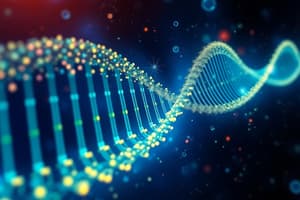Podcast
Questions and Answers
What does sequence comparison primarily help to achieve?
What does sequence comparison primarily help to achieve?
- Predicting the exact sequence of nucleotides
- Eliminating all mutations from sequences
- Determining the absolute length of sequences
- Constructing phylogenetic trees and identifying relationships (correct)
What role do gaps play in aligning sequences?
What role do gaps play in aligning sequences?
- They reduce the similarity score of sequences
- They only indicate errors in the alignment process
- They improve the alignment by representing missing characters (correct)
- They are unnecessary and should be avoided
Which type of homology refers to sequences in different species sharing a common ancestor?
Which type of homology refers to sequences in different species sharing a common ancestor?
- Orthologs (correct)
- Paralogs
- Homologs
- Analogs
What are substitution and scoring matrices used for in sequence alignment?
What are substitution and scoring matrices used for in sequence alignment?
How do mutations affect sequences over time?
How do mutations affect sequences over time?
What is the effect of gene duplication within a species?
What is the effect of gene duplication within a species?
How are amino acid properties utilized in sequence alignment scoring?
How are amino acid properties utilized in sequence alignment scoring?
What is the primary aim of using computational methods in sequence alignment?
What is the primary aim of using computational methods in sequence alignment?
What distinguishes PAM matrices from BLOSUM matrices?
What distinguishes PAM matrices from BLOSUM matrices?
When is it more appropriate to use protein sequences over DNA sequences in alignment?
When is it more appropriate to use protein sequences over DNA sequences in alignment?
What is a primary advantage of multiple sequence alignment (MSA) techniques?
What is a primary advantage of multiple sequence alignment (MSA) techniques?
What does BLAST primarily focus on when comparing sequences?
What does BLAST primarily focus on when comparing sequences?
What is the significance of the E-value in BLAST outputs?
What is the significance of the E-value in BLAST outputs?
Which of the following statements about BLAST is accurate?
Which of the following statements about BLAST is accurate?
What does the scoring matrix used in BLAST help with?
What does the scoring matrix used in BLAST help with?
What type of alignment method does Clustal Omega use to perform multiple sequence alignments?
What type of alignment method does Clustal Omega use to perform multiple sequence alignments?
Which of the following best describes codon degeneracy in the context of DNA to protein alignment?
Which of the following best describes codon degeneracy in the context of DNA to protein alignment?
Flashcards are hidden until you start studying
Study Notes
Sequence Alignment and BLAST
- A sequence is a series of symbols representing nucleotides (A, C, G, T for DNA, U for RNA) or amino acids
- Sequence comparisons are used to:
- Construct phylogenetic trees
- Identify relationships between genes/proteins
- Detect shared domains or motifs
- Analyze or annotate genomes
- Aligning sequences involves arranging them to identify regions of similarity
- Gaps represent positions where one sequence has a character while the other does not
- Scoring alignments can be done by:
- The number of identical positions
- Biochemical knowledge (like amino acid properties) that recognize conserved changes
- Homology refers to similarities between sequences due to shared ancestry (evolutionary relationship)
- Orthologs are sequences in different species that arose from a common ancestor during speciation
- Paralogs are sequences within a single species that arose through gene duplication
- Computational methods for sequence alignment use Substitution and scoring matrices
- PAM (Point Accepted Mutations) and BLOSUM (Blocks Substitution Matrix) assign scores to amino acid substitutions based on their likelihood
- Higher PAM numbers or lower BLOSUM numbers are suited for more distant relationships
- Protein alignment is often more informative due to the greater variety of amino acids compared to the four nucleotide bases in DNA
- Multiple sequence alignment (MSA) aligns more than two sequences to reveal deeper homologous relationships
- Clustal Omega is an algorithm that uses progressive alignment techniques to achieve MSA
- BLAST (Basic Local Alignment Search Tool) is a tool for rapidly comparing a query sequence against a database of sequences
- BLAST uses local alignment which focuses on specific regions of sequences rather than aligning them fully
- BLAST algorithm works in three phases:
- Word generation: Creates short subsequences (words) from the query sequence
- Database search: Scans the database for matches to these words
- Extension: Extends the found hits in both directions until the alignment score drops below a threshold
- BLAST output includes:
- Score
- E-value
- Query coverage
- Percent identity
- Smaller E-values indicate more significant matches
- E-value is similar to a p-value and determines the statistical significance of an alignment
- Different types of BLAST:
- blastn (nucleotide-nucleotide search)
- blastp (protein-protein search)
- blastx (translated nucleotide to protein search)
- tblastn (protein to translated nucleotide search)
- tblastx (translated nucleotide-nucleotide search)
- BLAST uses matrices like PAM or BLOSUM to score alignments
- The word size and scoring matrix can be adjusted by the user to balance between sensitivity and speed
Studying That Suits You
Use AI to generate personalized quizzes and flashcards to suit your learning preferences.




